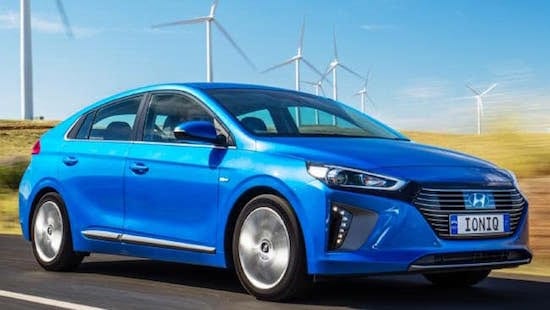 The latest electric vehicle offering from South Korean auto-maker Hyundai, the Ioniq sedan, has hit Australian roads as part of a 70-car fleet trial, ahead of a full retail market launch in the second half of 2018.
The latest electric vehicle offering from South Korean auto-maker Hyundai, the Ioniq sedan, has hit Australian roads as part of a 70-car fleet trial, ahead of a full retail market launch in the second half of 2018.
Hyundai said a hybrid electric version of the Ioniq, which was launched globally in 2016, was being used as a fleet car by the Australian Red Cross, the South Australian government and Northern Alliance Victoria, and had successfully covered many thousands of kilometres over the last two months.
The fleet roll-out precedes a broader market launch of the car, which has been billed as Hyundai’s answer to the Toyota Prius, that is scheduled for later this year.
That launch, says the car maker, will include all three of the Ioniq Ev variants – hybrid, plug-in hybrid and full electric – with pricing and full specification details to be announced closer to the launch date. In the US, the cars have retailed at around the $US30,000 mark.
The imminent arrival of another mass market model of electric vehicle on Australian shores promises another welcome boost to the local market, which has managed to go backwards in growth while the rest of the world has been taking off.
As well as the Ioniq, the second half of 2018 is expected to see the arrival of the new model Nissan LEAF, the Jaguar Land Rover I-Pace electric SUV, and maybe even Tesla’s mass market offering the Model 3 – although that is looking more likely to arrive in 2019.
“We had an opportunity to import a small number of Ioniq hybrids in advance of the full launch mid-year, so we placed them with fleet customers to get real-world feedback about the cars’ performance and practicality,” said Hyundai Australia’s chief operating officer Scott Grant, in comments on Friday.
“The fleet customers are leasing the cars at a special trial rate and so far the program is going extremely well. The car is well liked and is proving cost effective, reliable and comfortable to drive, with users averaging around 4.0l/100km in everyday urban driving. Feedback so far is very positive.”
Australian Red Cross fleet manager Greg McClure said the Ioniq was not only cost efficient, but included safety features on par with those you would expect from a “higher cost” vehicle.
“Overall we’re getting about 3.5L/100km and we’ve recorded about 900km to a tank. For the staff and volunteers using these cars this means fewer trips to fill up and more time in the communities we serve,” Grant said.
“We’re always trying to save costs, become more efficient and environmentally friendly, and having the latest technology for our fleet has been a great boost.”








